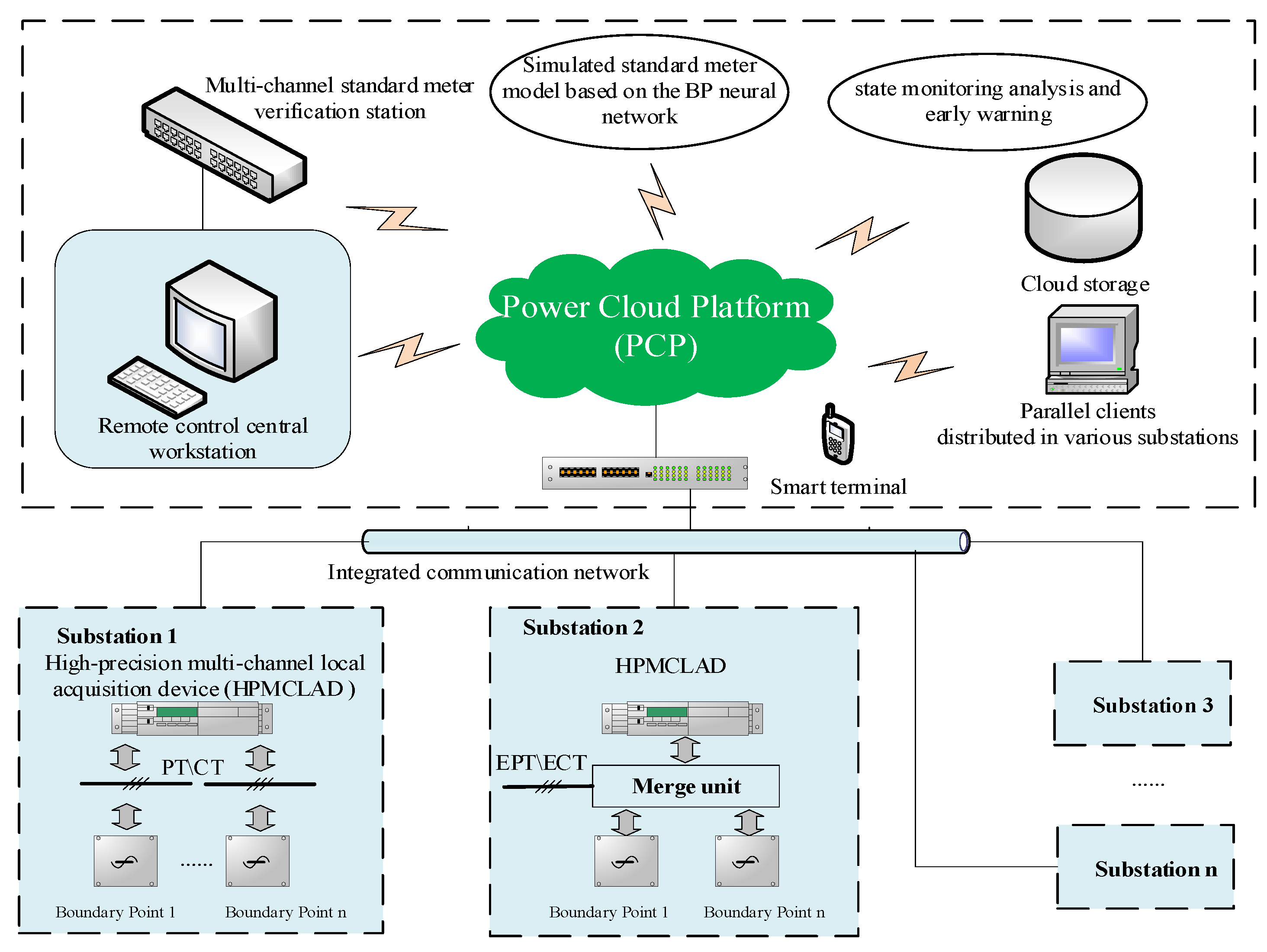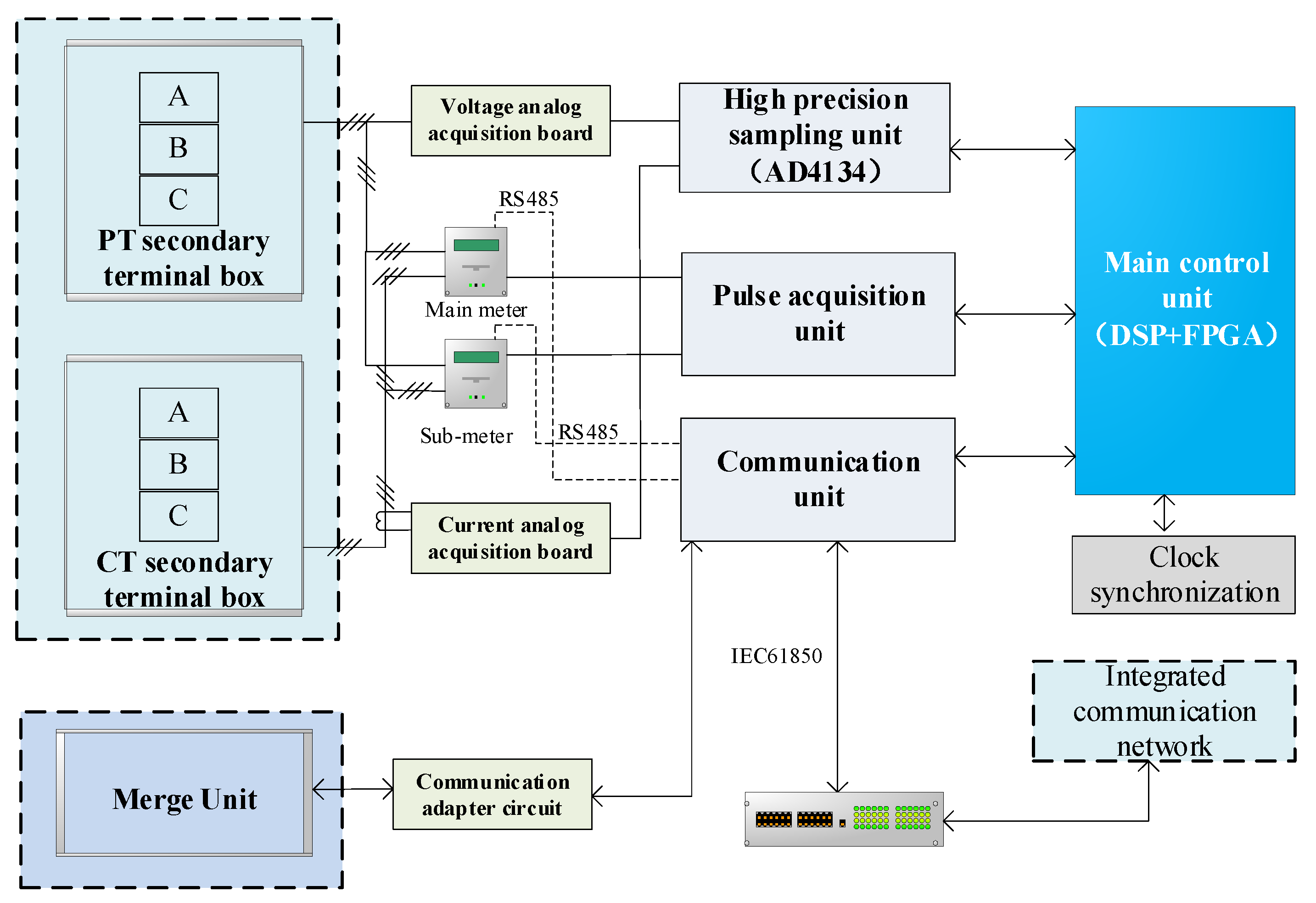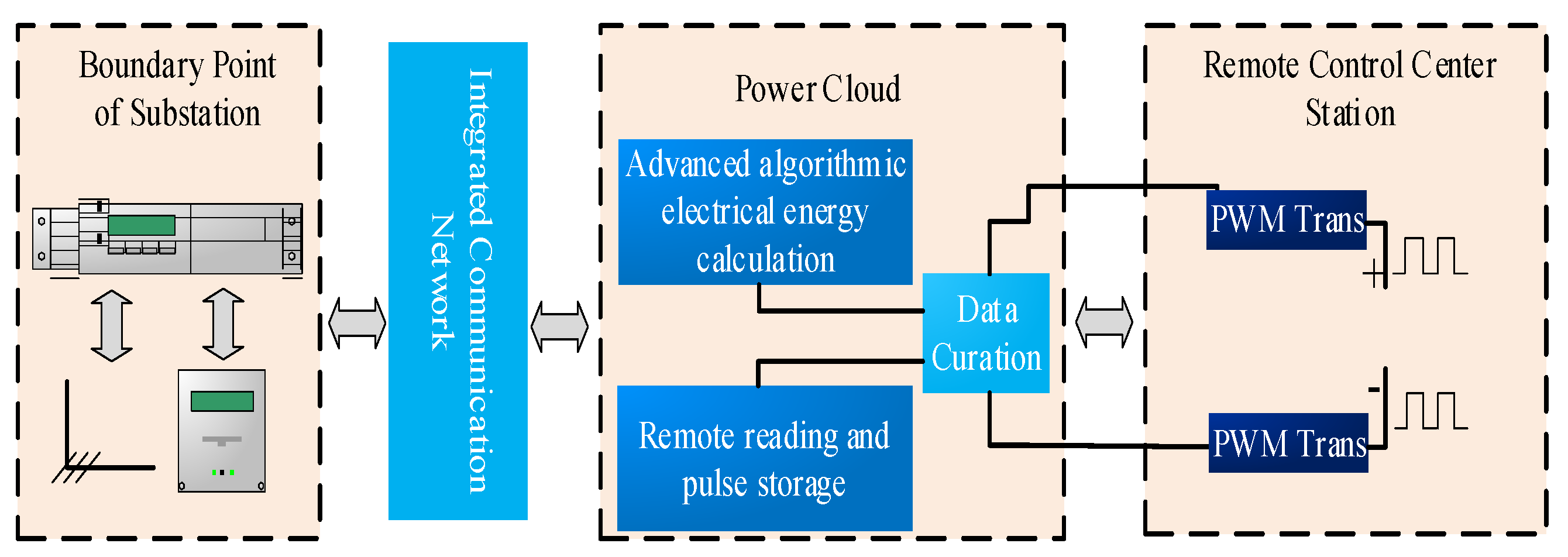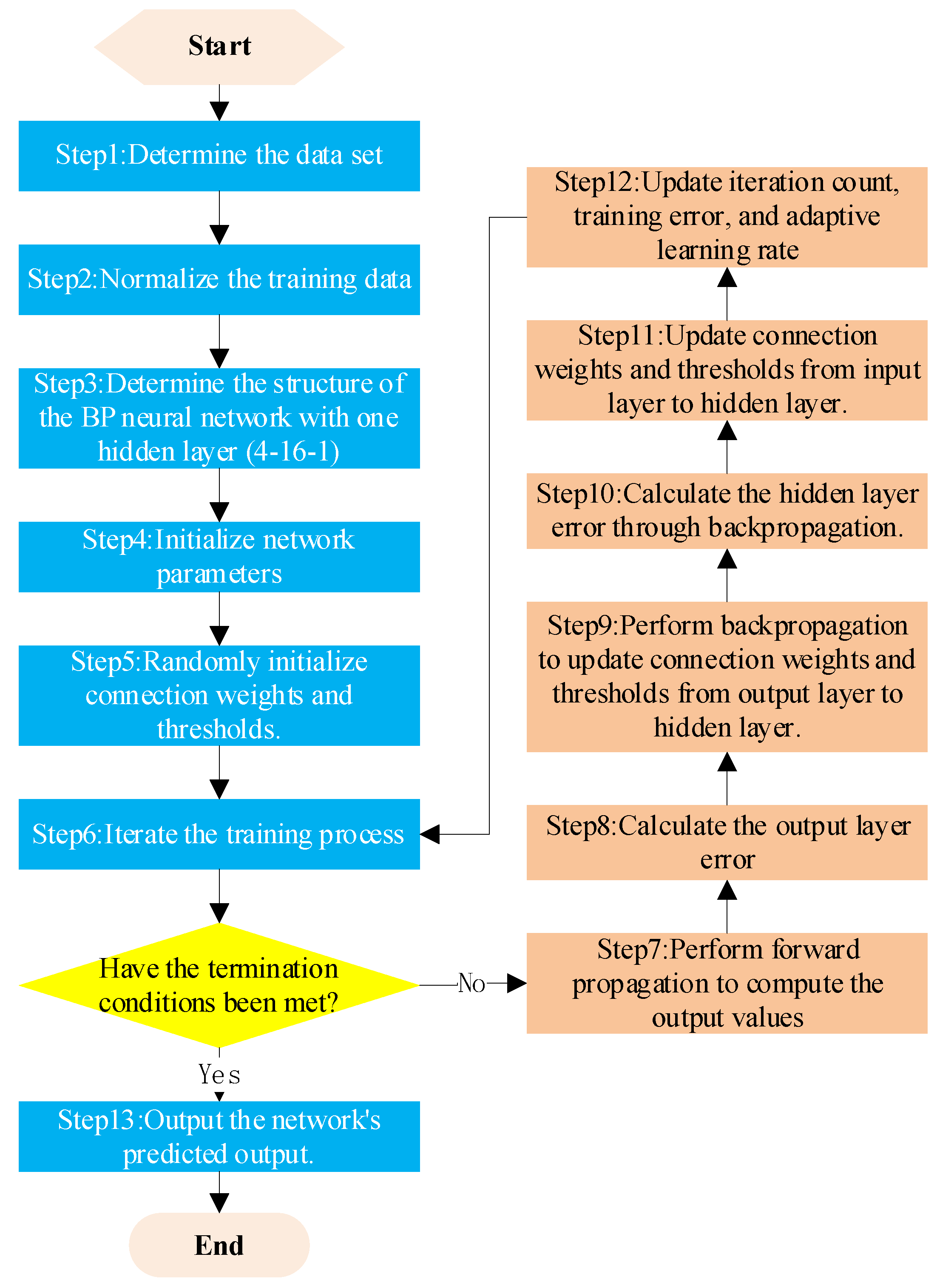Research on Intelligent Verification System of High Voltage Electric Energy Metering Device Based on Power Cloud
Abstract
1. Introduction
2. Overall Design of RVS for HVEEM Devices Based on PCP
3. Design of Major Modules for RVS
3.1. Design of HPMCLAD
3.2. Remote-Controlled PCP
4. Key Technologies
4.1. On-Site High-Precision Simultaneous Sampling
4.2. IEC 61850 Compliant Communication Modeling
4.3. Remote Verification Based on PCP
4.3.1. Remote Verification of Multi-Channel Pulse Standard Verification Device
4.3.2. Construction of Simulation Standard Meter Based on Improved BP Neural Network
5. Testing and Application Discussion
6. Conclusions
Author Contributions
Funding
Data Availability Statement
Acknowledgments
Conflicts of Interest
References
- Yang, L.; Zhang, D.; Lin, G.; Song, Q.; Meng, Q.; Pan, F.; Liu, C. Research on remote calibration and online monitoring system of electric energy metering device. J. Phys. Conf. Series. 2019, 1303, 12119. [Google Scholar] [CrossRef]
- Ding, Q.X. Improvement of Fault Diagnosis Technology for High-Voltage Power Metering Systems. Electr. Power Masses 2022, 8, 58–59. [Google Scholar]
- Li, G.; Jiang, X.Y.; He, D.Y.; Wu, Y.L. Research on Calibration Method of Electric Energy Metering System Based on Electronic Current Transformers. Autom. Instrum. 2021, 5, 92–96+101. [Google Scholar] [CrossRef]
- Sun, L. Research on Overall Calibration Technology of High Voltage Electric Energy Metering Devices in Distribution Networks. China New Technol. New Prod. 2019, 22, 47–48. [Google Scholar] [CrossRef]
- Yu, L.; Jing, J.; Liu, X.; Fan, J. Application of Intelligent Fault Diagnosis Technology for Power Metering Devices in the Context of Big Data. Power Syst. Equip. 2023, 2, 131–133. [Google Scholar]
- Wu, Y.X.; Liu, K.P.; Qin, L.; Zheng, X.; Wang, X.H. Research on Measurement Error of High-Voltage Direct Current Energy Metering Systems. Electr. Meas. Instrum. 2022, 9, 146–152. [Google Scholar] [CrossRef]
- Meng, Z.; Li, H.; Zhang, C.; Chen, M.; Chen, Q. Research on the reliability of capacitor voltage transformers calibration results. Measurement 2019, 146, 770–779. [Google Scholar] [CrossRef]
- Xia, T.; Lei, M.; Zheng, X.; Liu, C.C.; Yan, L.Q. Design of Online Monitoring System for Intelligent Substation Energy Metering Devices. Instrum. Tech. 2018, 5, 18–21. [Google Scholar] [CrossRef]
- Guan, S.L.; Zhao, Y.C.; Liu, F.R.; Zhao, Y.F. Operation Status and Improvement Measures of Remote Verification System for Electric Energy Metering Devices. China Metrol. 2018, 2, 105–106. [Google Scholar] [CrossRef]
- Lin, W.B.; Chen, L.; Xiao, Y.; Qian, B.; Xiao, Y.; Huang, S.L.; Zhao, W. Current Status and Development Trend of On-site Verification Technology for Electric Energy Meters. Electr. Meas. Instrum. 2016, 12, 1–6+41. [Google Scholar] [CrossRef]
- Zhu, K.; Yue, C.; Li, Z.; Yu, J.; Liu, Y. Study on hot-line calibration for 10kV watt-hour metering device. In Proceedings of the 2019 IEEE Sustainable Power and Energy Conference (iSPEC), Beijing, China, 21–23 November 2019; pp. 2675–2679. [Google Scholar] [CrossRef]
- Zhang, D.Q.; Yang, L.; Song, Q.; Meng, Q.L.; Pan, F. Development of a Multi-Channel Analog Data Acquisition Device for Remote Verification of Gateway Electric Energy Metering Devices. Electr. Meas. Instrum. 2022, 9, 181–187. [Google Scholar] [CrossRef]
- Cheng, F.Y.; Cao, M.; Lin, Z.A.; Wang, H.L.; Chen, Z.; Li, B.; Tang, B. Design of the Integrated Intelligent Detection Platform for Electric Energy Measuring Device. E3S Web Conf. 2020, 194, 3012. [Google Scholar] [CrossRef]
- Wang, Z.; Wang, H.Y.; Zeng, W.J.; Su, Y.P.; Duan, Y.J. Signal Reproduction Technology for Energy Meter Calibration Platform Based on Real Power Simulation. J. Northwest Univ. Nat. Sci. Ed. 2022, 52, 69–75. [Google Scholar] [CrossRef]
- Djokic, B.; Parks, H. Calibration of Electricity Meters with Digital Input. In Proceedings of the 2018 Conference on Precision Electromagnetic Measurements, Paris, France, 8–13 July 2018; pp. 1–2. [Google Scholar] [CrossRef]
- Li, H.; Chen, Q.Z.; Ma, H.B.; Xu, Z.M. Research on Intelligent Diagnosis Method for Electric Energy Metering Devices. Foreign Electron. Meas. Technol. 2019, 8, 52–56. [Google Scholar] [CrossRef]
- Du, J.; Fan, L.; Cui, Y.; Liang, H.; Liu, Y. An intelligent measuring device and its function realization method for deepening application in substation. In Proceedings of the 2022 IEEE 6th Advanced Information Technology, Electronic and Automation Control Conference (IAEAC), Beijing, China, 3–5 October 2022; pp. 929–932. [Google Scholar] [CrossRef]
- Tan, H.Y.; Yao, H.J.; Huang, Y.; Wang, H.N.; Zhao, Z.H.; Liu, Y. Error Correction Method for Smart Energy Meter Field Calibration System under Non-standard Conditions. In Proceedings of the 2020 4th International Conference on Smart Grid and Smart Cities (ICSGSC), Osaka, Japan, 18–21 August 2020; pp. 149–153. [Google Scholar] [CrossRef]
- Wu, Y.; Chen, C.; Yao, D.; Cao, R. Design of online calibration device for electric energy metering based on gps synchronous sampling. IOP Conf. Ser. Mater. Sci. Eng. 2019, 677, 42097. [Google Scholar] [CrossRef]
- Dubara, H.V.; Parihar, M.; Ramamritham, K. Smart Energy Meter Calibration: An Edge Computation Method: Poster. In Proceedings of the Twelfth ACM International Conference on Future Energy Systems, Online, 28 June–2 July 2021; pp. 280–281. [Google Scholar] [CrossRef]
- Li, Z.; Li, Q.; Wu, Z.; Li, Z. Research into an online calibration system for the errors of voltage transformers based on open–closed capacitor. Energies 2018, 11, 1455. [Google Scholar] [CrossRef]
- Li, Y.; Xu, B. Research on online calibration system based on ABB industrial robot. In Proceedings of the 2019 Chinese Automation Congress (CAC), Hangzhou, China, 22–24 November 2019; pp. 1299–1305. [Google Scholar] [CrossRef]
- Zhu, Z.; Dai, C.; Jiang, C.; Xu, Y. Development and Application of a Simulated Electric Energy Meter in an Electricity Information Acquisition System. In Proceedings of the 2022 IEEE 5th International Conference on Information Systems and Computer Aided Education (ICISCAE), Dalian, China, 23–25 September 2022; pp. 908–912. [Google Scholar] [CrossRef]
- Tang, D.P.; Wei, W.; Li, F.; Wang, X.X.; Yao, H. Research on Digital Electric Energy Meter Detection Technology Based on IEC 61850 Standard. Foreign Electron. Meas. Technol. 2018, 37, 56–62. [Google Scholar] [CrossRef]
- Barsana Banu, J.; Jeyashanthi, J.; Thameem Ansari, A.; Sathish, A. Development and implementation of the smart energy monitoring system based on IoT. In Advances in Smart Grid Technology: Select Proceedings of PECCON 2019; Springer: Singapore, 2021; Volume II, pp. 513–525. [Google Scholar] [CrossRef]
- Mlakić, D.; Baghaee, H.R.; Nikolovski, S.; Vukobratović, M.; Balkić, Z. Conceptual Design of IoT-Based AMR Systems Based on IEC 61850 Microgrid Communication Configuration Using Open-Source Hardware/Software IED. Energies 2019, 12, 4281. [Google Scholar] [CrossRef]
- Cai, Q.L.; Shuai, J.Q.; Shi, Q.J.; Feng, Q. Research and Application of Power Operation and Maintenance Cloud Platform Based on Microservices. Electr. Appl. 2021, 40, 43–47. [Google Scholar]
- Wu, Y.; Yao, D.F.; Chen, C.M.; Song, Y.J. Cloud-based Electric Energy Metering Device State Monitoring and Fault Diagnosis System. Power Capacit. React. Power Compens. 2021, 42, 197–202. [Google Scholar] [CrossRef]
- Wang, Y.; Huang, Y.; Lin, J.Y. Research on Data Processing Scheme for Power Industry Based on Cloud Platform. Electron. Des. Eng. 2022, 30, 155–158. [Google Scholar] [CrossRef]
- Ji, D.H. Design of Industrial Data Monitoring System Based on Cloud Platform; North China Electric Power University: Beijing, China, 2020. [Google Scholar] [CrossRef]
- Yang, J.; Guo, Y.; Guo, C.; Chen, Z.; Wang, S. Method to Quantifying the Logical Node Importance for IEC 61850 Based Substation Automation Systems. CSEE J. Power Energy Syst. 2023, 9, 272–283. [Google Scholar] [CrossRef]
- Claveria, J.; Kalam, A. The influence of IEC 61850 standard: Implementation and development of a functional substation automation simulator. Aust. J. Electr. Electron. Eng. 2020, 17, 28–35. [Google Scholar] [CrossRef]
- Wang, Z.; Gong, G.; Wen, Y. Anomaly Diagnosis Analysis for Running Meter Based on BP Neural Network. In Proceedings of the 2016 International Conference on Communications, Information Management and Network Security, Shanghai, China, 25–26 September 2016; Atlantis Press: Amsterdam, The Netherlands; pp. 90–92. [Google Scholar] [CrossRef]
- Yuan, X.; Zhang, P.; Li, N.; Xu, J.; Xiong, S. Error analysis method of intelligent electricity meter based on improved bp neural network. J. Phys. Conf. Ser. 2021, 1920, 12002. [Google Scholar] [CrossRef]
- Sun, Y.; Zhai, X.; Dong, X.; Xing, Y.; Sun, K. State Detection of Electric Energy Metering Device Using Computer Neural Network. In Proceedings of the 2022 IEEE 2nd International Conference on Data Science and Computer Application (ICDSCA), Dalian, China, 28–30 October 2022; pp. 392–395. [Google Scholar] [CrossRef]
- Zhang, J.; Cheng, Y.; Du, J.; Shu, Y.; Jiang, J.; Zhou, F.; Xiao, J. Research on abnormal diagnosis method of electric energy metering device based on BSO-BPNN. In Proceedings of the 2020 7th International Conference on Information Science and Control Engineering (ICISCE), Changsha, China, 18–20 December 2020; pp. 2448–2452. [Google Scholar] [CrossRef]
- Wang, X.; Cao, M.; Jiang, X.; Zhao, Y.; Li, X.; Zhao, X.; Jiang, T.; Yuan, Y. Measurement Error Prediction and Calibration of Gateway Energy Metering Device Based on BP Neural Network. J. Yunnan Minzu Univ. Nat. Sci. Ed. 2017, 26, 497–501. [Google Scholar] [CrossRef]
- Guo, H.; Wang, Z.; Jing, Z. Error Correction Research of High-Voltage Energy Metering Device Based on BP Neural Network. Power Grids Clean Energy 2020, 36, 6. [Google Scholar]
- Al_Duais, M.; Mohamad, F. Improved Time Training with Accuracy of Batch Back Propagation Algorithm Via Dynamic Learning Rate and Dynamic Momentum Factor. IAES Int. J. Artif. Intell. 2018, 7, 170. [Google Scholar] [CrossRef]
- Hou, S.; Liu, Y.; Xu, Y. Analysis and optimization of calibration method of digital energy meter. J. Phys. Conf. Series 2017, 887, 12034. [Google Scholar] [CrossRef]









| LN | Object | CDC | Definition |
|---|---|---|---|
| Measurement error verification | ErrNo | ING | Verification number |
| ErrVal | BCR | Error value | |
| ErrAvg | BCR | Mean value of error | |
| ErrAvgNum | ING | Number of error mean samples | |
| ErrVLim | ASG | Error alarm limit | |
| Errnum | ING | Number of verification turns | |
| ErrType | ING | Verification method (standard pulse verification or simulation standard meter verification) | |
| PT secondary pressure drop test | ErrPt | DEL | Voltage drop |
| Delta | WYE | phase angle difference | |
| FVal | WYE | ratio difference | |
| Transformer secondary load test | GVal | WYE | Conductance |
| BVal | WYE | Susceptance |
| Load Status | Load Current Interval | Power Factor (cosφ) | (%) | (%) | (%) | (%) |
|---|---|---|---|---|---|---|
| Balanced | 0.05Ib ≤ I < 0.1Ib | 1.0 | +0.009 | +0.011 | −0.014 | +0.041 |
| 0.05Ib ≤ I ≤ Imax | −0.007 | −0.005 | +0.011 | +0.032 | ||
| 0.1Ib ≤ I < 0.2Ib | 0.5 L | +0.006 | +0.010 | +0.015 | −0.026 | |
| 0.2Ib ≤ I ≤ Imax | −0.005 | +0.004 | −0.009 | −0.036 | ||
| 0.1Ib ≤ I < 0.2Ib | 0.8C | +0.009 | −0.011 | −0.012 | −0.034 | |
| 0.2Ib ≤ I ≤ Imax | −0.005 | −0.004 | +0.010 | +0.035 | ||
| Unbalanced | 0.1Ib ≤ I ≤ Imax | 1.0 | +0.009 | +0.013 | +0.013 | −0.043 |
| 0.1Ib ≤ I ≤ Imax | 0.5 L | −0.008 | +0.012 | +0.010 | −0.034 |
| Performance Metrics | Traditional Manual Verification Methods | Current Remote Calibration Systems | Proposed System in This Paper |
|---|---|---|---|
| Verification mode | Manual | Automatic | Automatic |
| Verification methods | On-site physical calibration | Remote physical verification | Remote physical verification or Remote Simulation Verification |
| Average time cost per test | 11.5 min | 1.3 s [38] | 1.0 s |
| Workload | High | Low | Low |
| Operational Risk | High | Low | Low |
| Compatibility | N/A | Partial Support | Support multi-vendor and multi-type device |
| Traceability | Difficult | Partial Support | Full Support |
| Maximum relative error | N/A | 1.24% [37] | +0.013% |
| Integrated Accuracy | N/A | 1.5 level | 0.02 level |
| Number of parallel verification devices supported | 1–2 | 10–50 (General physical server resources) | >100 (Parallel Computing Support of the PCP) |
| System Functions | N/A | Basic | Comprehensive |
Disclaimer/Publisher’s Note: The statements, opinions and data contained in all publications are solely those of the individual author(s) and contributor(s) and not of MDPI and/or the editor(s). MDPI and/or the editor(s) disclaim responsibility for any injury to people or property resulting from any ideas, methods, instructions or products referred to in the content. |
© 2023 by the authors. Licensee MDPI, Basel, Switzerland. This article is an open access article distributed under the terms and conditions of the Creative Commons Attribution (CC BY) license (https://creativecommons.org/licenses/by/4.0/).
Share and Cite
Zhang, F.; Guo, J.; Yuan, F.; Shi, Y.; Tan, B.; Yao, D. Research on Intelligent Verification System of High Voltage Electric Energy Metering Device Based on Power Cloud. Electronics 2023, 12, 2493. https://doi.org/10.3390/electronics12112493
Zhang F, Guo J, Yuan F, Shi Y, Tan B, Yao D. Research on Intelligent Verification System of High Voltage Electric Energy Metering Device Based on Power Cloud. Electronics. 2023; 12(11):2493. https://doi.org/10.3390/electronics12112493
Chicago/Turabian StyleZhang, Fangqing, Jiang Guo, Fang Yuan, Yongjie Shi, Bingyuan Tan, and Dongfang Yao. 2023. "Research on Intelligent Verification System of High Voltage Electric Energy Metering Device Based on Power Cloud" Electronics 12, no. 11: 2493. https://doi.org/10.3390/electronics12112493
APA StyleZhang, F., Guo, J., Yuan, F., Shi, Y., Tan, B., & Yao, D. (2023). Research on Intelligent Verification System of High Voltage Electric Energy Metering Device Based on Power Cloud. Electronics, 12(11), 2493. https://doi.org/10.3390/electronics12112493








